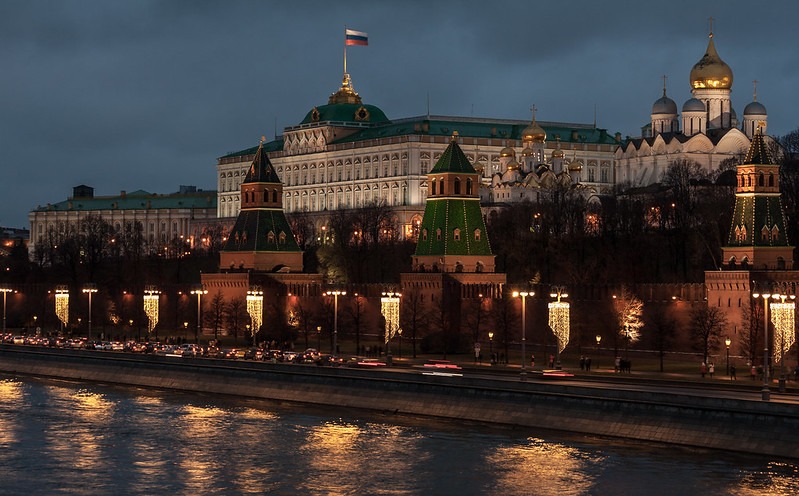Kremlin Palace, located in Moscow, the capital of Russia, is one of the country’s most important historical and political structures. Situated on the banks of the Moskva River, the Kremlin is a large complex surrounded by high walls. This area, which includes palaces, cathedrals, museums, and government buildings, has served as both a religious and political center for centuries. Originally built in the 12th century, the Kremlin was expanded during different periods and eventually took on its present magnificent form.
One of the most striking structures of the Kremlin Palace is the Grand Kremlin Palace. Built in the 19th century, this palace was used as the residence of emperors during the Tsarist Russia era. Today, it serves as one of the official residences and offices of the President of Russia. The palace’s interiors are highly ornate, featuring magnificent ceremonial halls, historical furniture, and works of art.
The Kremlin is not only a political center but also home to a rich cultural heritage. Structures such as the Golden-Domed Cathedrals, the Tsar Cannon, the Tsar Bell, and the Ivan the Great Bell Tower are of great architectural and historical significance. Listed as a UNESCO World Heritage Site, the Kremlin is visited by millions of tourists every year and continues to stand as an important symbol that sheds light on Russia’s history.
How to Get to the Kremlin Palace?

The Kremlin Palace is located in Moscow, the capital of Russia, on the banks of the Moskva River. Situated right in the heart of the city, the Kremlin lies directly next to Red Square. It is surrounded by high red brick walls, and entry is controlled through designated gates. The Kremlin is one of the most well-known and easily accessible tourist attractions in Moscow.
The most practical way to reach the Kremlin Palace is by using the metro. The Moscow metro system is highly developed and easy to navigate. The most convenient metro stations for reaching the Kremlin are Aleksandrovsky Sad, Biblioteka Imeni Lenina, Borovitskaya, or Okhotny Ryad. From any of these stations, it is possible to reach the Kremlin with a short walk. The outer area and surroundings of the palace can also be easily explored on foot from Red Square.
Visitors are required to purchase tickets to access certain sections of the Kremlin. Tickets can be obtained from the ticket offices near the Kremlin, located at the Museum of Cultural Heritage, or online through official websites. Visiting hours are generally between 10:00 AM and 5:00 PM; however, current hours and regulations should be checked from official sources. It is recommended to arrive early, especially during the summer and holiday periods, due to potential crowds.
ID Requirement for Entry to the Kremlin Palace
As the Kremlin Palace is a government complex, security measures are quite strict. Visitors may be asked to present identification, so a valid passport or ID card is required for entry.
Construction of the Kremlin Palace

The foundations of the Kremlin Palace were laid in the 12th century, with the establishment of the city of Moscow in 1147. The first structure was built during the reign of Prince Yuri Dolgorukiy as a fortress for defensive purposes. Initially constructed with wooden materials, this early version of the Kremlin was later rebuilt with stone due to increasing attacks and the city’s development. In the 14th century, when Moscow became the center of the Russian Orthodox Church, the Kremlin transformed into not only a military stronghold but also a religious and administrative center.
In the 15th century, under the rule of Ivan III (Ivan the Great), the Kremlin began to take on its current magnificent form. Ivan III brought architects from Italy to reconstruct the Kremlin’s walls and significant buildings within. During this period, red brick walls, towers, and religious structures were added. The Cathedral of the Dormition, designed by Italian architect Aristotele Fioravanti, became one of the Kremlin’s most important religious buildings.
In the 19th century, by the order of Tsar Nicholas I, the Grand Kremlin Palace was constructed within the Kremlin. This structure was designed as a residence for the imperial family and a venue for state ceremonies. Russian architects Konstantin Thon, Fedor Richter, and other notable figures took part in its construction. With hundreds of rooms, this grand building stands out as an example that reflects both Russian architectural traditions and classical European palace architecture. Today, the Kremlin Palace continues to be one of Russia’s political and cultural symbols through its historical development and architecture.
How Is the Kremlin Palace Used Today?

Today, the Kremlin Palace serves as the political center of the Russian Federation. The Grand Kremlin Palace, located within the Kremlin complex, is the official residence of the President of Russia and the site of certain state meetings. Although the President primarily resides elsewhere, the Kremlin Palace is actively used for important meetings, receptions of international delegations, and state ceremonies.
The Kremlin functions not only as a political center but also as a historical and cultural site open to the public. The cathedrals, museums, and historic buildings within the palace complex are accessible to tourists. The Armoury Chamber (Oruzheynaya Palata) is particularly popular for its display of crowns, thrones, jewelry, and historic weapons that belonged to Russian tsars. Additionally, the Kremlin squares and cathedrals can be used for special occasions by the Russian Orthodox Church.
A part of the Kremlin Palace is also used by the Federal Protective Service of Russia and the Presidential Administration. Therefore, some areas are closed to the public and are maintained under strict security measures. Overall, the Kremlin continues to function in multiple roles today—as both the administrative center of the state and a cultural heritage site that sheds light on Russian history.
What Are the Architectural Features of the Kremlin Palace?

The Kremlin Palace is part of the Kremlin, located in the center of Moscow and considered one of Russia’s most important historical and cultural landmarks. The architectural features of the palace reflect its historical development and include elements from various periods. Here are some details about the architectural characteristics of the Kremlin Palace:
Construction Period and Historical Development: The Kremlin Palace was built in the 16th century. The initial structures began during the reign of Ivan III and were gradually expanded over time. Later, especially during the era of Peter the Great, numerous modifications were made. The structure seen today carries influences from multiple historical periods.
Renaissance and Byzantine Influence: The Kremlin Palace displays clear traces of Byzantine and Renaissance architecture. The mosaics and frescoes on the walls reflect Byzantine influence, while stylistic and structural elements from the Renaissance period are also evident.
Grand Hall (St. George’s Hall): One of the most significant interior spaces of the palace, this hall stands out with its elegant columns and large dome. It is used for major state ceremonies and important meetings.
Exterior Facade: The exterior of the Kremlin Palace bears the marks of traditional Russian architecture. The red brick walls, grand towers, and large gates are notable features. The facade has been shaped by additions and restorations over time.
Domes and Roofs: The Kremlin Palace features numerous domes and roofs, often gilded with gold. These are among the most recognizable elements of traditional Russian architecture.
Interior Spaces and Decoration: The interiors of the palace are decorated with luxury and grandeur. Gold-embellished walls, large chandeliers, crystal windows, and rich carpets enhance the palace’s majestic atmosphere. The frescoes and paintings inside depict scenes from Russia’s history and culture.
Size and Functionality: The Kremlin Palace is a vast complex composed of many rooms and halls. Serving various state functions, it has also operated as the governmental center of Russia.
Interesting Facts About the Kremlin Palace

The Kremlin Palace is one of the most significant symbols of Russia’s history and culture. With its rich historical background and distinctive architecture, this structure has been at the center of many transformations and events over time. Here are some interesting facts about the Kremlin Palace:
1. Different Uses During the Tsarist and Soviet Periods
During the Tsarist era, the Kremlin Palace served as the center of government and a venue for state ceremonies. In the Soviet period, many parts of the Kremlin were used for revolutionary meetings, state administration, and party activities.
2. Construction of the Grand Kremlin Palace
The construction of the Grand Kremlin Palace began in 1837 by order of Emperor Nicholas I and was completed in 1849. The palace was built with a blend of classical Russian and Renaissance styles, with a particularly magnificent exterior. The stones used in its construction were sourced from various regions of Russia.
3. Peter the Great’s Influence and Renovations
Peter the Great had a major influence on the Kremlin Palace. In the early 1700s, he initiated innovative architectural changes to modernize the palace and make it more comparable to European courts. Some parts of the palace were redesigned based on Western European models.
4. The “Golden Dome” of the Kremlin
One of the most striking features of the Kremlin Palace is its gold-covered domes. Especially the cathedral domes in the Kremlin are gilded and have become symbols of the Russian Orthodox faith. These domes also represent Russia’s power and grandeur.
5. A Ceremonial Venue During the Soviet Era
During the Soviet Union, the Kremlin Palace hosted various state ceremonies, party congresses, and national celebrations. Soviet victory parades and military processions often took place here. Lenin’s Mausoleum, located in the Kremlin area, was built as a special monument to the founder of the Soviet Union.
6. Once Home to Two Different Palaces
Another interesting addition to the Kremlin was the Tsar’s Palace, which symbolized a different form of government. During the Tsarist period, this parallel structure highlighted the dual nature of state power in Russia. It functioned alongside the Kremlin Palace.
7. The Great Bell of the Kremlin
Near the Kremlin Palace is the Tsar Bell, considered the largest bell in the world. Cast in 1735, this massive bell has never been rung. Weighing 200 tons, it holds great historical significance. A broken piece from the bell, resulting from a fire during restoration in 1930, is still visible today.
8. “Palace Day” at the Kremlin
On specific days each year, the Kremlin hosts “Palace Day” events. This includes exhibitions showcasing the palace’s functions and historical roles. It serves as a reminder that the Kremlin is not only the center of government but also a vital part of Russian cultural heritage.
9. The Soviet Revolution of 1961 and the Kremlin Palace
The revolution in 1961 significantly altered the political use of the Kremlin Palace. In the early years of Soviet rule, the palace’s interior was transformed to suit Soviet culture and functions while still retaining its status as a government center.
10. Magnificent Ceiling Frescoes of the Kremlin
The interior of the Kremlin Palace is especially famous for its ceilings. The frescoes feature detailed and elegant depictions of Russian Orthodox icons. Each room contains frescoes with different themes, symbolizing Russia’s deep religious and cultural history.
The Kremlin Palace is not only a cornerstone of Russia’s historical and cultural heritage but also one of the most important architectural landmarks in world history. As the seat of government, it has embodied the evolution of Russian identity from the Tsarist era to the Soviet Union and into the modern day. From its golden domes and historic frescoes to its grand interiors and monumental bell, every detail of the Kremlin Palace carries deep meaning tied to the past and future of the Russian people.
More than just a tourist attraction, the Kremlin offers visitors a profound journey through Russia’s past. Every corner of it is a bearer of centuries-old cultural legacy. Today, with symbolic significance for both Russia and the world, the Kremlin continues to carry the splendor of the past into the future. Exploring this grandeur provides an unforgettable experience for anyone interested in history and culture.
